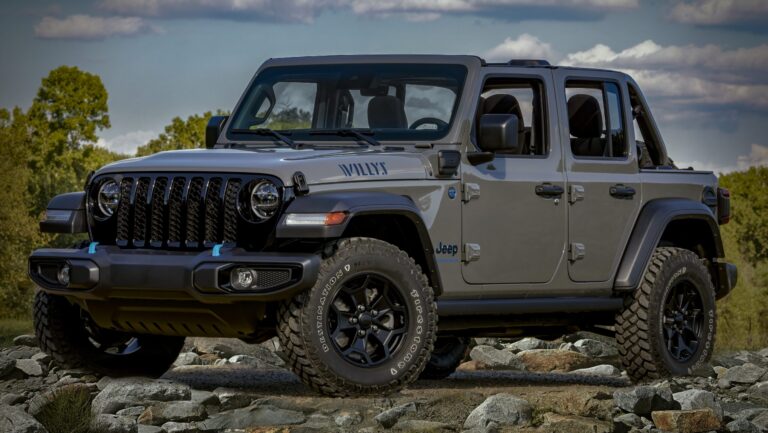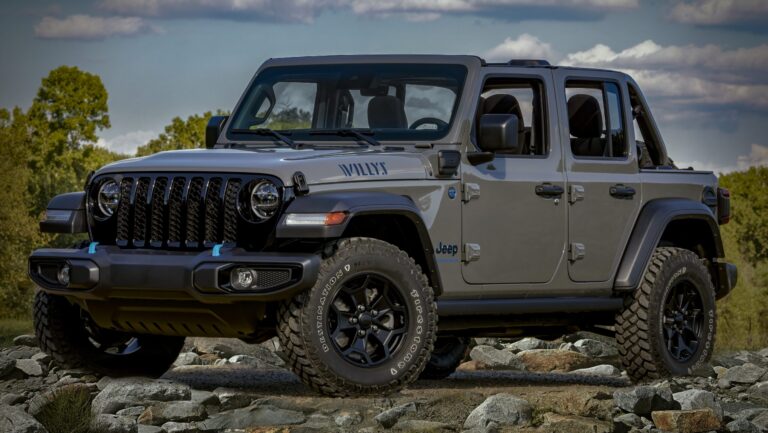304 Jeep Engine For Sale: Your Comprehensive Guide to Reviving a Classic
304 Jeep Engine For Sale: Your Comprehensive Guide to Reviving a Classic jeeps.truckstrend.com
The rumble of a V8 engine under the hood of a classic Jeep is a sound that resonates deeply with enthusiasts. Among the various powerplants that graced these iconic off-roaders, the AMC 304 cubic inch V8 holds a special place. Simple, robust, and capable of delivering ample torque for both trail and tarmac, the 304 has powered countless Jeeps through decades of adventure. If you’re a proud owner of a vintage CJ, Wagoneer, or J-series truck in need of a heart transplant, or embarking on a meticulous restoration, the search for a "304 Jeep Engine For Sale" is likely at the top of your list.
This comprehensive guide is designed to navigate you through the world of buying, assessing, and understanding the AMC 304 V8 engine. We’ll explore its enduring legacy, where to find it, what to look for, and crucial considerations to ensure you make an informed decision that gets your classic Jeep roaring back to life.
304 Jeep Engine For Sale: Your Comprehensive Guide to Reviving a Classic
The Enduring Legacy of the AMC 304 V8
The AMC (American Motors Corporation) 304 V8 engine was a staple in Jeep vehicles from the early 1970s through the early 1980s. Introduced in 1971, it quickly became a popular option, offering a significant power upgrade over the standard inline-six engines of the era.
Key Facts about the AMC 304:
- Displacement: 304 cubic inches (5.0 liters)
- Configuration: V8, overhead valve (OHV)
- Bore x Stroke: 3.75 in x 3.44 in (95.25 mm x 87.38 mm)
- Horsepower & Torque: Varied by year and carburetor setup, generally ranging from 120-150 horsepower and 245-250 lb-ft of torque. While these numbers might seem modest by modern standards, the engine’s strong low-end torque was perfectly suited for off-road applications and the relatively light weight of Jeeps.
- Vehicles it powered: Most notably, the CJ-5 and CJ-7, but also found in the J-series pickups (J10, J20), the Wagoneer, and the Cherokee (SJ).

Why the 304 Remains Popular:
- Simplicity and Reliability: The 304 is a relatively straightforward engine design, making it easier for home mechanics to work on. Its robust cast-iron block and basic components contribute to its longevity.
- Torque Delivery: Its strong low-end torque is ideal for rock crawling, towing, and general off-road prowess, allowing Jeeps to conquer challenging terrain without excessive revving.
- Classic Sound: There’s nothing quite like the distinctive V8 burble of a well-tuned 304. It’s part of the authentic classic Jeep experience.
- Parts Availability: Despite its age, many common wear parts (gaskets, bearings, pistons, etc.) are still readily available from aftermarket suppliers, making rebuilds feasible.
- Authenticity: For restoration projects, a period-correct 304 is often preferred to maintain the vehicle’s original integrity and value.


Why Buy a 304 Jeep Engine? Common Scenarios
The decision to purchase a 304 Jeep engine usually stems from one of several common needs:
- Engine Replacement: This is the most frequent reason. If your existing 304 has suffered catastrophic failure (e.g., thrown rod, cracked block, severe overheating damage), a replacement engine is necessary to get your Jeep back on the road or trail.
- Restoration Project: For enthusiasts aiming for a factory-correct restoration of a vintage CJ or Wagoneer that originally came with a 304, sourcing a good core or a freshly rebuilt engine is paramount.
- Engine Swap (Less Common): While larger V8s like the AMC 360/401 or Chevrolet 350 are often chosen for power upgrades, some owners might opt for a 304 swap into a Jeep that originally had a smaller inline-six. This provides a V8 feel with less weight and packaging hassle than a larger engine, maintaining a more "original" character.
- Building a Spare/Project Engine: Dedicated enthusiasts might purchase a 304 core to slowly rebuild it over time, creating a ready-to-go spare or a performance-modified engine for a future project.
Where to Find a 304 Jeep Engine For Sale
Finding a 304 engine can be a treasure hunt, but knowing where to look significantly improves your chances:
-
Online Marketplaces:
- eBay: A vast selection, but requires careful vetting of sellers and understanding shipping logistics.
- Craigslist/Facebook Marketplace: Excellent for local finds, saving on shipping. Be prepared to inspect in person.
- Dedicated Jeep Forums & Classifieds: Websites like JeepForum.com, Pirate4x4.com, and specific AMC/Jeep enthusiast groups on Facebook often have "for sale" sections where members list engines. These communities can also provide valuable insights and advice.
-
Specialized Salvage Yards & Junkyards: Look for salvage yards that specialize in older vehicles or classic Jeeps. These are increasingly rare but can be goldmines for original parts. Call ahead to inquire about their inventory.
-
Engine Rebuilders & Suppliers: Several companies specialize in remanufactured or rebuilt classic engines. These often come with a warranty, providing peace of mind, but at a higher price point. Examples include Jasper Engines (though less common for specific vintage engines) or smaller, independent builders focusing on AMC V8s.
-
Private Sellers: Word-of-mouth within the classic car/Jeep community, local classifieds, and auto parts swap meets can yield results.
Tips for Sourcing:
- Be Patient: Finding the right engine in the right condition can take time.
- Ask for Details: Don’t be shy about asking for detailed photos, videos of it running (if applicable), and any history the seller can provide.
- Check Seller Reputation: Look at reviews, forum feedback, or ask for references.
- Beware of Scams: If a deal seems too good to be true, it probably is. Never send money without verifying the product and seller.
Types of 304 Jeep Engines Available (and What to Look For)
The condition of a 304 engine for sale will heavily influence its price and the work required. Here are the common categories:
-
Core Engine (As-Is/Needs Rebuild):
- Description: This is typically a non-running engine, often seized, incomplete, or pulled from a vehicle that was totaled. It’s bought primarily for its block, crankshaft, and cylinder heads, which will require machining and new components.
- What to Look For:
- Cracked Block: The absolute deal-breaker. Inspect thoroughly for cracks, especially around freeze plugs, main bearing caps, and cylinder walls. A cracked block usually means the engine is scrap.
- Rust/Corrosion: Excessive internal rust can indicate water intrusion and might make components unusable.
- Missing Components: Note what’s included (e.g., intake manifold, exhaust manifolds, oil pan, valve covers, distributor, carburetor, accessory brackets). Missing parts add to the overall cost.
- Crankshaft Condition: Rust pitting or severe scoring on the journals might make it unusable or require extensive grinding.
-
Used/Running Pull-Out Engine:
- Description: An engine removed from a running vehicle. Its condition can range from "ran okay" to "ran rough but still ran." It might be a good candidate for a refresh or minor repairs, but often needs a full rebuild for reliability.
- What to Look For:
- Compression Test: Crucial. Ask for compression numbers for all cylinders. Low or widely varying numbers indicate internal wear.
- Oil Pressure: If possible, see it run and check oil pressure. Low pressure is a red flag.
- Leaks: Look for oil, coolant, or fuel leaks.
- Noises: Listen for knocks, rattles, or excessive valvetrain noise if you can hear it run.
- Oil Condition: Milky oil suggests coolant contamination; very dark/sludgy oil indicates poor maintenance.
- Service History: Any records of past maintenance or mileage are a bonus.
-
Rebuilt/Remanufactured Engine:
- Description: An engine that has been professionally disassembled, inspected, machined, and reassembled with new wear parts (pistons, rings, bearings, camshaft, lifters, oil pump, timing chain, etc.). These are the most expensive but should be ready to install.
- What to Look For:
- Warranty: A reputable rebuilder will offer a warranty (e.g., 1-3 years). Understand its terms.
- Builder Reputation: Research the company or individual.
- Specs of Work Done: Get a detailed list of what was replaced, machined (e.g., bored cylinders, ground crankshaft), and any upgrades.
- Dyno Sheet (Rare but ideal): Proof it runs and meets specified power.
- New Components: Confirm new pistons, rings, bearings, gaskets, oil pump, timing set, etc.
Important Considerations Before Buying
Beyond the engine itself, several factors will influence your purchase and project:
- Budget: Clearly define your budget. A cheap core might seem appealing but can quickly exceed the cost of a rebuilt engine once machining, parts, and labor are factored in. Don’t forget shipping costs, which can be substantial for an engine.
- Shipping & Logistics: Engines are heavy. If buying remotely, you’ll need freight shipping, which requires a commercial address with a loading dock or forklift, or a local freight terminal for pickup. Get multiple quotes.
- Ancillary Components: Does the engine come with all necessary peripherals?
- Carburetor (or fuel injection setup)
- Distributor and ignition system
- Exhaust manifolds
- Accessory brackets (alternator, power steering pump, A/C compressor)
- Flywheel (manual transmission) or flexplate (automatic transmission)
- Fan, fan shroud, water pump, thermostat housing
- These items, if missing, can add hundreds to thousands of dollars to your project.
- Compatibility: While a 304 is a 304, minor variations exist (e.g., different accessory mounts or sensor locations depending on the year). Generally, they are highly interchangeable within the AMC V8 family.
- Your Skill Level: Are you comfortable with an engine swap, or will you need professional help? Factor in labor costs.
- Legalities: Ensure you get a bill of sale, especially if the engine has a serial number that could be tracked.
Installation and Post-Purchase Tips
Once you’ve acquired your 304, the journey continues:
- Pre-Installation Inspection: Even with a rebuilt engine, inspect it thoroughly before dropping it in. Check for shipping damage, loose bolts, or anything out of place.
- New Peripherals: Plan to replace all gaskets, hoses, belts, spark plugs, and wires. Consider a new water pump, oil pump (if not already part of a rebuild), and a performance timing chain set.
- Break-in Procedure: If you purchased a rebuilt engine, follow the builder’s specific break-in instructions meticulously. This is crucial for piston ring seating and cam lobe longevity.
- Tuning: After installation, proper tuning of the carburetor and ignition timing is essential for optimal performance and longevity.
- Fluid Selection: Use high-quality engine oil (often conventional, non-synthetic for older engines, especially during break-in) and appropriate coolant.
- Professional Assistance: Don’t hesitate to seek professional help from a reputable mechanic if you encounter issues beyond your expertise. An engine swap is a significant undertaking.
304 Jeep Engine For Sale: Estimated Price Guide
Prices for a 304 Jeep engine vary widely based on condition, completeness, seller, and location. The table below provides estimated ranges to give you a general idea. Always get specific quotes and verify what’s included.
| Engine Type/Condition | Estimated Price Range (USD) | What’s Typically Included | Notes/Considerations |
|---|---|---|---|
| Core Engine (As-Is) | $200 – $800 | Bare block, crank, heads, sometimes oil pan/valve covers | Requires full rebuild (machining, all new internals). High risk of cracked block. Good for experienced builders. |
| Used/Running Pull-Out | $500 – $1,500 | Engine block, heads, intake, exhaust manifolds, sometimes carburetor/distributor, accessories. | Condition highly variable. Always request compression test results. Plan for a refresh or rebuild for reliability. |
| Refurbished/Refresh | $1,500 – $3,000 | Engine with new gaskets, bearings, minor wear parts. | Often from a shop that did a basic "freshen up." May not involve full machining. Verify scope of work. |
| Professionally Rebuilt/Remanufactured | $3,000 – $6,000+ | Fully machined block, new pistons, rings, bearings, cam, lifters, oil pump, timing set, all gaskets. | Best option for reliability and longevity. Typically includes a warranty. Verify builder’s reputation and detailed specs. |
Disclaimer: These are general estimates as of late 2023/early 2024 and can fluctuate significantly based on market demand, scarcity, geographic location, and the specific seller. Always conduct thorough research and obtain detailed quotes.
Frequently Asked Questions (FAQ)
Q1: Is the AMC 304 a good engine?
A1: Yes, for its era and intended purpose, the 304 is a good, reliable engine. It’s known for its simplicity, durability, and excellent low-end torque, making it well-suited for classic Jeep applications, especially off-roading.
Q2: What Jeep models came with the 304 V8?
A2: The AMC 304 was primarily found in Jeep CJ-5 and CJ-7 models from 1971 to 1981. It was also an option in some J-series pickups (J10, J20), the Wagoneer, and the Cherokee (SJ body style) during that period.
Q3: Can I swap a 304 into a Jeep that didn’t originally have one?
A3: Yes, it’s possible. Swapping a 304 into a Jeep that originally had an inline-six (like a 258 or 232) is a common conversion. It requires different engine mounts, a V8 bell housing, exhaust modifications, and potentially radiator/cooling system upgrades. It’s a more involved project than a direct replacement but less complex than swapping in a non-AMC V8.
Q4: What’s the typical horsepower of a 304 Jeep engine?
A4: Depending on the year and specific tuning (carburetor, emissions equipment), the 304 typically produced between 120 and 150 horsepower, and around 245-250 lb-ft of torque. Its strength lies in its low-end torque, which is crucial for off-road performance.
Q5: What should I look for when inspecting a used 304 engine?
A5: Key inspection points include:
- Visual: Look for cracks in the block or heads, excessive rust, obvious damage, or missing components.
- Oil: Check under the oil cap for sludge (poor maintenance) or milky residue (coolant contamination).
- Running Engine: If possible, listen for knocks, rattles, or excessive smoke. Get a compression test and check oil pressure.
- History: Ask the seller about the engine’s history, mileage, and why it was removed.
Q6: How much does it cost to rebuild a 304?
A6: The cost to rebuild a 304 varies widely based on parts needed, labor rates, and whether you do it yourself or hire a professional. Expect costs for parts (pistons, rings, bearings, gaskets, cam, lifters, oil pump, etc.) to range from $800-$2,000, plus machine shop labor for boring, honing, crank grinding, and head work (another $1,000-$2,500+). Professional assembly labor can add another $1,000-$2,500. So, a full professional rebuild can easily cost $3,000 to $6,000 or more.
Q7: Where can I find parts for a 304?
A7: Many common wear parts for the 304 are still readily available from major auto parts retailers (e.g., Summit Racing, Jegs, RockAuto), classic Jeep parts specialists (e.g., Quadratec, Morris 4×4 Center), and engine component manufacturers (e.g., Sealed Power, Federal-Mogul). Specific AMC performance parts might require more specialized searching.
Conclusion
The AMC 304 V8 remains a beloved and capable engine, perfectly suited for the spirit of classic Jeep adventures. While finding a "304 Jeep Engine For Sale" can be an exciting prospect, it’s a purchase that demands careful consideration, thorough inspection, and a clear understanding of your project’s needs. By arming yourself with knowledge about the different types of engines available, where to look, and what questions to ask, you can confidently acquire the heart your vintage Jeep deserves. With the right 304 under the hood, you’ll not only preserve a piece of automotive history but also ensure countless more miles of reliable, torquey fun on and off the beaten path.





